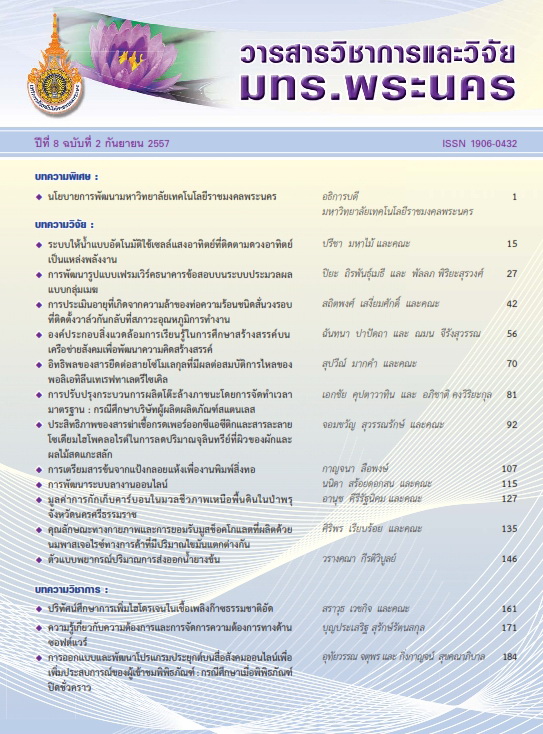ปริทัศน์ศึกษาการเพิ่มไฮโดรเจนในเชื้อเพลิงก๊าซธรรมชาติอัด
Main Article Content
Abstract
บทคัดย่อ
ในบทความนี้นำเสนอการรวบรวมผลศึกษา แนวทางในการพัฒนาเทคโนโลยีการใช้เชื้อเพลิงไฮโดรเจนร่วมกับเชื้อเพลิงก๊าซธรรมชาติอัด หรือ Hydrogen-enriched Compressed Natural Gas (HCNG) ประเด็นเรื่องของอัตราส่วนการผสมกันระหว่างเชื้อเพลิงไฮโดรเจนกับก๊าซธรรมชาติอัดที่เหมาะสมพบว่าอัตราส่วนผสมที่ให้สมรรถนะและการปล่อยไอเสียที่สมดุลย์กันจะมีเชื้อเพลิงไฮโดรเจนสัดส่วน 20%-30% โดยปริมาตร โดยที่อัตราส่วนดังกล่าวยังสามารถลดอัตราส่วนสมมูลย์ลงให้อยู่ในช่วง 0.5 – 0.6 นอกจากนี้ การปรับองศาการจุดระเบิดให้ช้าลง (Ignition Delay) ประมาณ 5 องศาการหมุนของเพลาข้อเหวี่ยงเพื่อชดเชยความเร็วในการเผาไหม้ที่เปลี่ยนแปลงไป การใช้ HCNG ที่สัดส่วน 20%-30% โดยปริมาตรยังส่งผลทำให้สารประกอบ HC และก๊าซ NOx ในไอ-เสียมีปริมาณลดลงเมื่อเปรียบเทียบกับการใช้ก๊าซ CNG เพียงอย่างเดียว ในส่วนของการออกแบบระบบการจ่ายเชื้อเพลิงนั้น ระบบเก็บและฉีดก๊าซทั้งสองชนิดแยกจากกันจะให้ความยืดหยุ่นและทำให้สามารถปรับเปลี่ยนอัตราส่วนผสมของเชื้อเพลิงให้เหมาะสมต่อสภาวะการใช้งานได้ ซึ่งในปัจจุบันยังไม่มีการพัฒนาระบบดังกล่าวในเชิงพาณิชย์
Abstract
This article presents a collection of studies relating to the development of technologies using hydrogen with compressed natural gas or Hydrogen-enriched Compressed Natural Gas (HCNG). Regarding to the issues of mixing ratio, the data show that the appropriated amount of hydrogen falls between 20%-30% by volume in order to balance any tradeoff between engine performance and emissions. The equivalent ratio can be adjusted to be as low as 0.5-0.6. The ignition timingmust also be retarded (Ignition Delay) by averagely 5 degrees of crankshaft rotation to compensate for the change of burning speed. Theuse of 20%-30% of hydrogen by volume decrease both HC and NOx as compared to the use of CNG alone. In terms of the fuel system design, the individually-stored gas injection system is of interest. It provides flexibility especially for the adjustment of the fuel composition for optimum ration in any operating conditions. But at present, there is no commercial development of such system.


